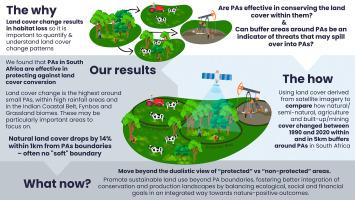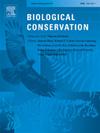南非保护区及其周边的土地覆被变化
IF 4.9
1区 环境科学与生态学
Q1 BIODIVERSITY CONSERVATION
引用次数: 0
摘要
土地植被变化和栖息地丧失是生物多样性面临的主要威胁,而保护区(PAs)在缓解这一威胁方面发挥着至关重要的作用。本研究将南非保护区网络内剩余的自然植被与保护区周围 5 公里的缓冲区进行了比较。这种比较既可以作为附近土地利用变化对保护区造成的直接威胁的指标,也可以作为保护区内自然植被完整性的衡量标准。这项工作是通过比较三十年来在保护区和缓冲区内收集到的不同规模、不同生物群落和不同降雨梯度的卫星衍生土地覆被等级(自然/半自然;农业;建筑/采矿)来完成的。面积较大、降雨量较低的保护区自然覆盖率最高。然而,保护区外 1 公里处的自然覆盖率下降了 14.8%,与保护区外的全国平均自然覆盖率相当。5 公里缓冲区内的土地覆被发生了显著变化,尤其是在高降雨量地区和较小的保护区周围,印度洋海岸带、芬波斯和草原生物群落的变化最为明显。为了实现全球保护目标和满足人类需求,在划出土地用于保护的同时,还必须采取其他措施。除了保护保护区内的自然景观外,保护区还应该促进保护区边界外土地的可持续利用。我们主张采取新的基于区域的保护措施,平衡生态、社会和经济目标,促进保护与生产景观的更好结合。本文章由计算机程序翻译,如有差异,请以英文原文为准。

Land cover change in and around South African protected areas
Land cover change and habitat loss are major threats to biodiversity, with protected areas (PAs) playing a crucial role in mitigation. This study compares the natural cover remaining within South Africa's PA network to a 5-km buffer zone around PAs. This comparison acts as an indicator of the imminent threats posed to PAs by nearby land use changes and as a measure of the integrity of natural land cover within them. This is done by comparing satellite-derived land cover classes (natural/semi-natural; agriculture; built-up/mining) collected over three decades within PAs and buffers across various PA sizes, in different biomes and across a rainfall gradient.
Results show that South Africa's PAs, which cover nearly 10 % of the country, have more natural land cover than their associated buffer zones. Larger and low-rainfall PAs retain the highest natural cover. However, natural cover drops by 14.8 % just 1 km outside PAs, mirroring the national average natural cover outside PAs. Significant land cover change occurs within the 5-km buffer, especially in high-rainfall areas and around smaller PAs, with the most pronounced changes in the Indian Ocean Coastal Belt, Fynbos, and Grassland biomes.
These changes in the buffer limit PA expansion opportunities and pose risks to their integrity. To meet global conservation targets and human needs, setting land aside for conservation must be complemented by additional initiatives. Beyond protecting natural landscapes within, PAs should promote sustainable land use beyond their boundaries. We argue for new area-based conservation measures that balance ecological, social, and financial goals, fostering better integration of conservation and production landscapes.
求助全文
通过发布文献求助,成功后即可免费获取论文全文。
去求助
来源期刊

Biological Conservation
环境科学-环境科学
CiteScore
10.20
自引率
3.40%
发文量
295
审稿时长
61 days
期刊介绍:
Biological Conservation is an international leading journal in the discipline of conservation biology. The journal publishes articles spanning a diverse range of fields that contribute to the biological, sociological, and economic dimensions of conservation and natural resource management. The primary aim of Biological Conservation is the publication of high-quality papers that advance the science and practice of conservation, or which demonstrate the application of conservation principles for natural resource management and policy. Therefore it will be of interest to a broad international readership.
 求助内容:
求助内容: 应助结果提醒方式:
应助结果提醒方式:


